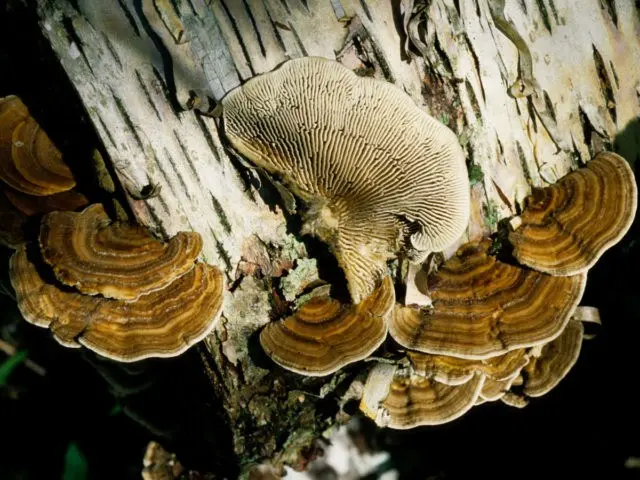Contents
Lenzites birch is a member of the Polyporov family, the genus Lenzites. The Latin name is Lenzites betulina. Also known as lencites or birch trametes. It is an annual parasitic fungus that, when settling on wood, causes white rot in it.
What does birch lenzites look like

This mushroom grows in large groups
The fruit body of this specimen is presented in the form of a single hat without a stem. The cap is thin, semi-rosette shaped with sharp edges, its size varies from 2 to 10 cm in diameter. The surface is covered with a velvety, hairy or felted whitish color when young, and gray or cream when mature. It is divided into concentric zones with lighter edges, whitish, yellowish-ochre, grayish-brown or brown. Quite often, in old mushrooms, the pubescence is covered with colorful algae. On the underside of the cap are plates that are strongly branched and intertwined with each other. At the initial stage of maturation, they are painted white, after a while they become light cream or yellow-buff. Spores are cylindrical, thin-walled and colorless.
The pulp is thin, tough, leathery, elastic, in old mushrooms it is almost cork. It has a spicy aroma and unexpressed taste.
Where does Lenzites birch grow?

This species grows throughout the summer and autumn.
The fruiting bodies of this species are annuals. Most often found in areas of the Northern Hemisphere, which is characterized by a temperate climate. It prefers to settle on the fallen birches, thanks to which it received the corresponding name. But besides this, the species in question also grows on deadwood of other hardwood trees, stumps and deadwood. Favorable time for fruiting is the period from June to November.
Is it possible to eat birch lenzites
This species is one of the inedible mushrooms. Despite the fact that it does not contain toxic substances, birch lenzites is not suitable for food due to the particularly hard pulp.
Conclusion
Lenzites birch is an annual parasitic fungus. You can meet him throughout the summer and autumn on stumps, deadwood, trunks or thick branches of deciduous trees, less often conifers. Due to its hard pulp, it is not suitable for food, however, some mushroom pickers collect fruits for medicinal purposes and prepare decoctions or alcohol tinctures.









